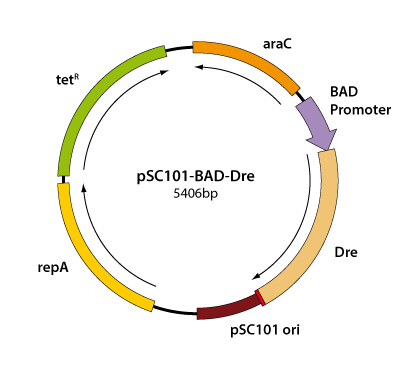 Back to list
Back to list
pSC101-BAD-Dre
Manual [PDF] Contact Support Order
Limited Use Licence
The use of the this product is governed by the terms and conditions of the limited use license: Dre Material.
The use of Dre recombinase is covered by United States Patent Nos. 7,422,889 and 7,915,037 owned by the Stowers Institute for Medical Research, Kansas City, Missouri. Non-profit and academic institutions have permission to use the plasmid solely for research purpose; for-profit entities require a license from Stowers Institute.
Description
Site-specific recombinases (SSRs) like Cre or Dre are valuable tools in functional genomics and have been applied in various organisms. They mediate recombination between target sites of 32-34 base pairs (bp) in length. The target sites, which are called loxP or rox sites are 13-14 bp palindromes separated by spacers:
| loxP | 5-ATAACTTCGTATAATGTATGCTATACGAAGTTAT-3 |
| rox | 5-TAACTTTAAATAATGCCAATTATTTAAAGTTA-3 |
Recognition sites of the site-specific recombinases Cre (loxP) and Dre (rox).
Cre recombinase, which was originally isolated from coliphage P1, mediates recombination between two loxP-sites through the spacer regions (e.g. removal of selectable genes). Dre was identified in a systematic search through P1-like phages for a Cre-like enzyme that had diverged sufficiently to recognize a recombination target site (RT) that is distinct from loxP (Sauer and Mc Dermott, 2004).
The combination of the arabinose inducible BAD promoter and the low-copy pSC101 plasmid backbone provide an excellent on-off regulation of Cre or Dre in E. coli as proved in a test experiment (Anastassiadis et al. 2009).
The plasmids carry a tetracyclin resistance gene for selection and are compatible with plasmids based on a ColE1 or p15A origin of replication and an ampicillin or kanamycin resistance marker.
While Cre/loxP is widely used in mouse genetics for conditional mutagenesis with many mouse lines available, a second highly efficient system like Dre/rox opens the door for more complex tasks such as a conditional mutagenesis of alternatively spliced exons. Cre/loxP can be used to remove one alternative exon and Dre/rox to remove the other one.
Map of pSC101-BAD-Dre
Contents
- Recombinase expression plasmid pSC101-BAD-Dre (0.2 µg/µl, 20 µl)
- Manual



